.
C. Gordon Fullerton, who compiled a distinguished career as a NASA astronaut, research pilot and Air Force test pilot spanning almost 50 years, died Aug. 21. He was 76.
Fullerton had sustained a severe stroke in late 2009, and had been confined to a long-term care facility in Lancaster, Calif., for most of the past 3½ years.
Fullerton logged 382 hours in space flight on two space shuttle missions while in the NASA astronaut corps from 1969 to 1986. He then transferred to NASA's Dryden Flight Research Center at Edwards Air Force Base, where he served for 22 years as a research test pilot on a variety of high-profile projects. During the latter years of his career at NASA Dryden, he served as Associate Director of Flight Operations and as chief of the directorate's flight crew branch prior to his retirement at the end of 2007.
A native of Portland, Ore., Fullerton earned bachelor's and master's degrees in mechanical engineering from the California Institute of Technology and then joined the U. S. Air Force in 1958.
After assignments flying both fighters and bombers, Fullerton attended the Air Force Aerospace Research Pilot School at Edwards in 1964. After two years as a test pilot at Wright-Patterson Air Force Base in Ohio, he was selected for the Air Force Manned Orbiting Laboratory program in 1966. Following cancellation of that program in 1969, Fullerton was assigned by the Air Force to NASA's astronaut corps at the Johnson Space Center.
Fullerton served on the support crews for the last four Apollo lunar missions, and was part of one of two crews who flew the space shuttle prototype Enterprise during the Approach and Landing Test program at NASA Dryden in 1977.
Fullerton flew into space on the space shuttle Columbia during the eight-day STS-3 orbital flight test mission in March 1982. That mission became the only shuttle mission to land at White Sands, N.M., because Rogers Dry Lake at Edwards was flooded by heavy seasonal rains.
He then commanded the shuttle Challenger on the STS-51F Spacelab 2 mission in 1985. That flight carried 13 major experiments in the fields of astronomy, solar physics and life and materiel science.
At NASA Dryden, Fullerton was the project pilot on the NB-52B launch aircraft, flying initial launches of the Pegasus rocket, the X-38 Crew Recovery Vehicle and the hypersonic X-43A. He was pilot-in-command of NASA's modified Boeing 747 Shuttle Carrier Aircraft on numerous ferry flights of space shuttles from Edwards to the Kennedy Space Center.
Fullerton flew numerous other research programs at Dryden, including the F-15 and MD-11 Propulsion Controlled Aircraft project, and was project pilot for high-speed landing tests of space shuttle landing gear components installed on a modified Convair 990 jetliner. He flew NASA's DC-8 Airborne Science laboratory worldwide on a variety of environmental research studies, and flew the first test flights of NASA's Stratospheric Observatory for Infrared Astronomy. He was also one of only two non-Russian pilots to fly the Tu-144 supersonic transport.
Fullerton retired from the Air Force with the rank of colonel after 30 years of active duty in 1988. He piloted more than 135 different types of aircraft during his Air Force and NASA career, amassing more than 16,000 flight hours.
Fullerton was honored with numerous civil and military awards during his career. He was inducted into the Astronaut Hall of Fame in 2005, the International Space Hall of Fame in 1982 and was a Fellow of the Society of Experimental Test Pilots.
Funeral arrangements are pending at Halley-Olsen-Murphy Memorial Chapel in Lancaster. A funeral mass is scheduled for 10 a.m. Saturday, Aug. 24, at Sacred Heart Catholic Church in Lancaster, followed by a celebration of Fullerton's life at NASA Dryden on Monday, Aug. 26, beginning at 10 a.m.
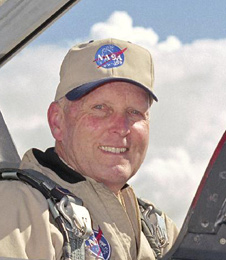
C. Gordon Fullerton
.
C. Gordon Fullerton retired from the National Aeronautics and Space Administration on Dec. 31, 2007, after a distinguished career as an Air Force test pilot, NASA astronaut, and research test pilot spanning more than 49 years.
Fullerton logged 382 hours in space flight on two space shuttle missions while serving in the NASA astronaut corps from September 1969 until November 1986. He then joined the Flight Crew Branch at NASA's Dryden Flight Research Center, where he served for 22 years as a research test pilot on a variety of high-profile projects. During the latter years of his career at NASA Dryden, he served as Associate Director of Flight Operations and as chief of the directorate's flight crew branch, often called its chief pilot, responsible for a variety of flight research and administrative support activities.
Fullerton earned Bachelor of Science and Master of Science degrees in mechanical engineering from the California Institute of Technology, Pasadena, Calif., in 1957 and l958, respectively. After working briefly as a mechanical design engineer for Hughes Aircraft Co., he then entered the U. S. Air Force in July 1958.
Following flight school, Fullerton was first trained as an F-86 interceptor pilot, and later became a B-47 bomber pilot at Davis-Monthan Air Force Base, Tucson, Ariz. He was then selected to attend the Air Force Aerospace Research Pilot School (now the Air Force Test Pilot School), Edwards Air Force Base, Calif., in 1964. Upon graduation he was assigned as a test pilot with the Bomber Operations Division at Wright-Patterson Air Force Base, Dayton, Ohio. His test flying experience led to his being selected to be a flight crewmember for the Air Force Manned Orbiting Laboratory program from 1966 until that program was canceled in 1969.
Fullerton was then assigned by the Air Force to NASA's astronaut corps at the NASA Johnson Space Center, Houston, where he served on the support crews for the Apollo 14, 15, 16, and 17 lunar missions. In 1977, Fullerton was assigned to one of the two flight crews that piloted the space shuttle prototype Enterprise during the Approach and Landing Test program at Dryden.
Fullerton was the pilot on the eight-day STS-3 space shuttle orbital flight test mission March 22-30, 1982. The mission exposed the orbiter Columbia to extremes in thermal stress and tested the 50-foot Remote Manipulator System used to grapple and maneuver payloads in orbit. That mission became the only space shuttle mission to land at White Sands, N.M., because Rogers Dry Lake at Edwards was too wet to support a landing due to heavy seasonal rains.
Fullerton was commander of the STS-51F Spacelab 2 mission, launched on July 29, 1985. That mission, on the shuttle orbiter Challenger, was the first pallet-only Spacelab mission and the first to operate the Spacelab Instrument Pointing System. It carried 13 major experiments in the fields of astronomy, solar physics and ionospheric, life and materiel science. The mission ended Aug. 6, 1985, with a landing at Edwards.
Upon his transfer to NASA Dryden at Edwards Air Force Base, Fullerton became the project pilot on the NASA NB-52B launch aircraft and was heavily involved in the return of that aircraft to flight status after a four-year downtime. Fullerton flew the B-52 on the first six air launches of the commercially developed Pegasus rocket. He was involved in a series of development air launches of the X-38 Crew Recovery Vehicle and in the Pegasus launches for the hypersonic X-43A Hyper-X supersonic-combustion ramjet ("scramjet") project.
Fullerton was the project pilot on the Propulsion Controlled Aircraft project, during which he successfully landed both a modified F-15 and an MD-11 transport with all control surfaces neutralized, using only engine thrust modulation for control.
As a pilot for NASA's DC-8 Airborne Science flying laboratory, Fullerton deployed worldwide to support a variety of research studies, including atmospheric physics, ground mapping and meteorology. He was also pilot-in-command on the first test flights of NASA's Stratospheric Observatory for Infrared Astronomy, or SOFIA, following major modifications to the 747SP to integrate the observatory's 2.5-meter infrared telescope.
Fullerton was assigned to evaluate the flying qualities of the Russian Tu-144 supersonic transport during two flights in 1998, becoming one of only two non-Russian pilots to fly that aircraft. He also served as project pilot for a series of high-speed landing tests of space shuttle landing gear components installed on a modified Convair 990 jetliner.
Fullerton flew in numerous other research programs at Dryden, including the C-140 JetStar Laminar Flow Control, F-111 Mission Adaptive Wing, F-14 Variable Sweep Flow Transition, space shuttle drag chute and F-111 crew module parachute tests on the B-52, X-29 vortex flow control and experiments on the F-18 Systems Research Aircraft. He also served as pilot-in-command of NASA's modified Boeing 747 Shuttle Carrier Aircraft on numerous ferry flights of space shuttles mounted atop the 747's fuselage from Edwards to the Kennedy Space Center.
Fullerton was on active duty in the Air Force for 30 years, rising to the rank of colonel, prior to his retirement from the service in 1988. He piloted more than 135 different types of aircraft during his Air Force and NASA career, amassing more than 16,000 flight hours.
Among the special awards and honors Fullerton has received are the Iven C. Kincheloe Award from the Society of Experimental Test Pilots in 1978; Department of Defense Distinguished Service and Superior Service Medals; Air Force Distinguished Flying Cross; NASA Distinguished and Exceptional Service Medals; NASA Space Flight Medals in 1983 and 1985; General Thomas D. White Space Trophy; Haley Space Flight Award from the American Institute of Aeronautics and Astronautics; American Astronautical Society Flight Achievement Awards for 1977, 1981 and 1985; the Certificate of Achievement Award from the Soaring Society of America; and the Ray E. Tenhoff Award from the Society of Experimental Test Pilots in 1992 and 1993.
Fullerton was inducted into the Astronaut Hall of Fame in 2005, and the International Space Hall of Fame in 1982. He is a Fellow of the Society of Experimental Test Pilots, a member of the Tau Beta Pi honorary engineering fraternity and a Fellow of the American Astronautical Society.
Fullerton had been in declining health since suffering a severe stroke in late 2009, and died on Aug. 21, 2013.
.
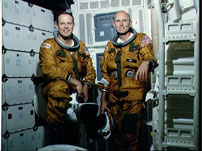
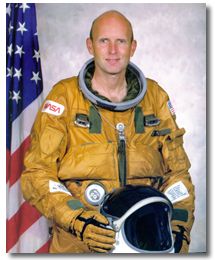
Columbia-STS-3 Crew photo with Commander Jack R. Lousma Pilot C. Gordon Fullerton.
.
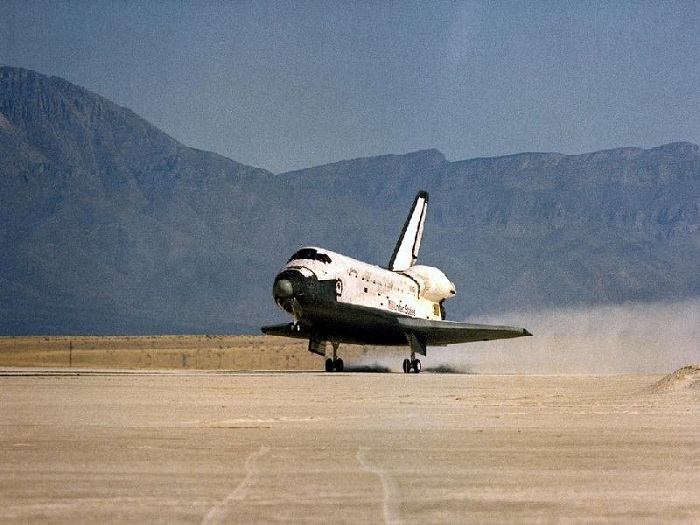
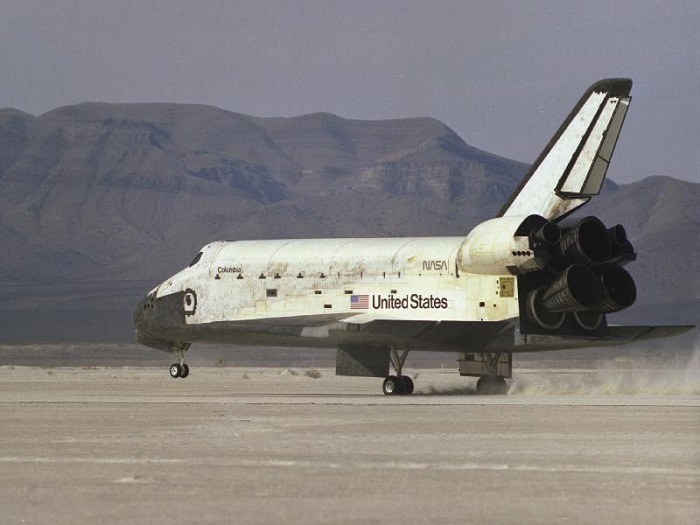
STS-3
EC82-18507
Shuttle Columbia Landing
Space shuttle Columbia touches down on the gypsum surface of Northup Strip at the U.S. Army's White Sands Missile Range in New Mexico to conclude the third space shuttle mission on March 30, 1982. Crewed by NASA astronauts Jack Lousma and Gordon Fullerton, Columbia had been diverted from its planned landing at Edwards Air Force Base in Southern California due to bad weather the previous week having left Edwards' lakebed runways too soggy to support a shuttle landing. Two months later, President Ronald Reagan signed legislation renaming the Northrup Strip area as White Sands Space Harbor.
March 30, 1982
.
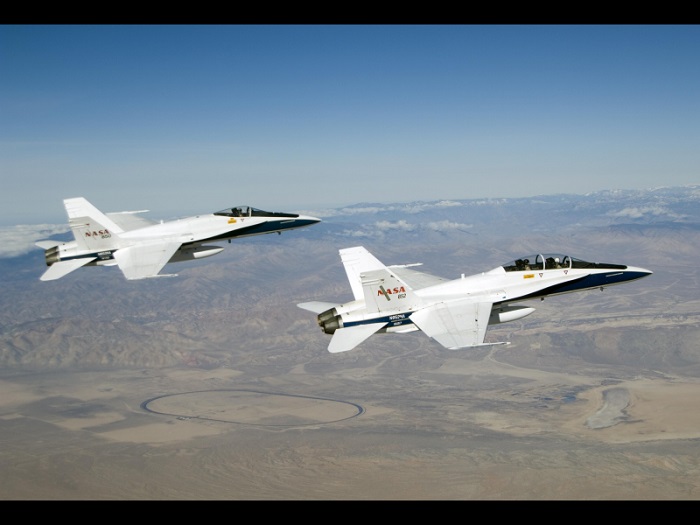
Quelle: NASA

